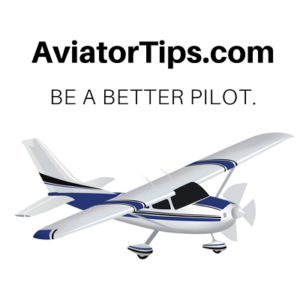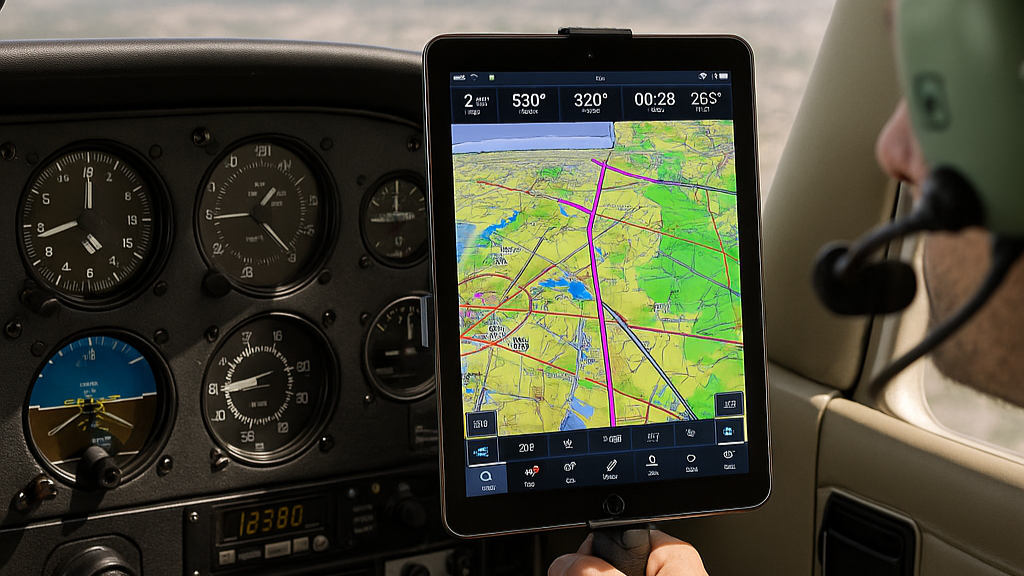Technology has changed nearly every aspect of flying, and nowhere is that more obvious than in the rise of the Electronic Flight Bag, or EFB. For student pilots and new private pilots, EFBs offer a powerful set of tools that help with planning, navigation, weather awareness, and in-flight decision making, all from one portable device.
An EFB is more than just a fancy app or digital map. It is a complete cockpit companion that replaces stacks of paper charts, flight plan forms, checklists, and reference guides. It helps pilots work smarter, not harder, and makes flying more efficient, organized, and safe.
What Is an Electronic Flight Bag?
An Electronic Flight Bag (EFB) is a tablet or electronic device used by pilots to display aviation data, plan and monitor flights, and access essential information in real time. EFBs are typically loaded with flight apps like ForeFlight, Garmin Pilot, or FltPlan Go and are paired with devices such as ADS-B receivers for additional data.
Instead of flipping through a bulky kneeboard stuffed with charts and documents, pilots using EFBs have access to:
- VFR and IFR charts
- Airport directories and diagrams
- METARs and TAFs
- NOTAMs and TFRs
- Flight planning tools
- Aircraft performance calculators
- Checklists and manuals
- Navigation maps and weather overlays
With the right app and accessories, an EFB can serve as a full command center for both VFR and IFR operations.
EFB Components and Setup
To turn a tablet into an effective EFB, you need a few key components:
1. Tablet (iPad or Android)
Most pilots use an iPad (standard, Mini, or Pro) due to app compatibility and reliability. Some aviation apps also support Android tablets.
2. Flight App
Popular EFB software includes:
- ForeFlight: iOS only, industry-leading with extensive features.
- Garmin Pilot: iOS and Android, integrates well with Garmin avionics.
- FltPlan Go: Free option that includes charts, nav logs, and weather.
- WingX and FlyQ: Other well-rated apps with strong followings.
3. ADS-B Receiver (Optional but Recommended)
Devices like the Sentry, Stratus, or Garmin GDL 50 provide:
- Real-time traffic
- In-flight weather
- GPS positioning
- Attitude and synthetic vision (on some models)
4. Mount and Power Supply
A yoke or suction-cup mount helps position your tablet for easy viewing. A backup battery or charging cable is also a must, especially on longer flights.
How EFBs Simplify Pilot Workflows
Now let’s break down how an EFB streamlines each part of a typical flight workflow.
1. Preflight Planning
Before even leaving the house, you can open your EFB and start planning your flight. Features that simplify the process include:
- Route Planning: Drag-and-drop routes with instant updates to headings, distances, and times.
- Fuel and Performance Calculations: Built-in calculators for weight, balance, fuel burn, and runway lengths.
- Weather Briefings: Access METARs, TAFs, radar imagery, satellite, winds aloft, and graphical forecasts.
- NOTAMs and TFRs: Stay clear of restricted airspace and runway closures with updated alerts.
- Filing Flight Plans: Submit VFR or IFR flight plans directly from the app with just a few taps.
This means less time flipping through documents and calling flight service stations, and more time focused on getting your aircraft and mindset ready for the flight.
2. Airport Familiarization
EFBs let you:
- View airport diagrams with taxi instructions
- Access FBO information, fuel prices, and services
- Read pilot comments and airport notes (ForeFlight)
- Preview instrument procedures and approach plates
- Check sunrise/sunset and pattern altitudes
This makes new airports much less intimidating and helps you brief your arrival and departure with confidence.
3. In-Flight Navigation
During the flight, your EFB shines as a real-time navigation tool:
- Moving Map: See your aircraft’s position on sectional or IFR charts.
- Terrain Awareness: Color-coded terrain warnings help you avoid high ground.
- Traffic Display: ADS-B traffic shows nearby aircraft on your map.
- Weather Updates: See radar and METAR updates while enroute (with ADS-B).
- Airspace Alerts: Get notified before entering controlled or restricted airspace.
- Synthetic Vision: For some apps, a 3D display of the terrain improves spatial awareness.
EFBs reduce heads-down time and help you focus on flying and looking outside, not fiddling with paper charts or handheld GPS units.
4. Checklists and Aircraft Data
Most EFBs allow you to upload or access:
- Custom and standard aircraft checklists
- Aircraft documents (POH, supplements, etc.)
- Emergency procedures
- Performance charts and graphs
Having everything in one place speeds up your cockpit flow and helps you handle abnormal or emergency situations more efficiently.
5. Flight Logging and Postflight Debrief
After the flight, your EFB helps you log hours and learn from your experience:
- Automatic Logbook Entry: Apps like ForeFlight log time, location, and route automatically.
- Track Review: See your flight path, altitudes, and speeds on a map.
- Debrief with Instructors: Use your recorded track to discuss performance, accuracy, or deviations.
Over time, these records can help identify strengths, weaknesses, and areas to improve.
EFB Benefits for Student and New Pilots
- Confidence: EFBs reduce information overload and help you stay organized.
- Efficiency: Spend less time on paperwork and more time learning to fly.
- Situational Awareness: Real-time alerts and maps help prevent airspace violations and terrain risks.
- Learning Support: Instructors can use EFB recordings and data to provide more focused feedback.
- Safety: The combination of weather, traffic, and navigation information enhances overall safety margins.
EFB Limitations and Best Practices
Despite all the advantages, there are some important points to remember:
- Know the Tool: Spend time learning how your EFB works before relying on it in flight.
- Maintain Situational Awareness: Don’t get distracted by the screen. Always fly the airplane first.
- Keep a Backup: Bring paper charts or a second device as backup in case your EFB fails.
- Pre-Load Data: Download charts, procedures, and weather before takeoff.
- Follow FAA Rules: Some commercial or IFR flights require approved systems. For VFR, personal EFBs are generally fine.
Are EFBs Legal for Student Pilots?
Yes, student pilots are allowed to use EFBs during solo flights as long as:
- They know how to use it safely
- They meet the preflight planning requirements
- They carry backup materials if required by their instructor or flight school
Many instructors encourage EFB use during training to build familiarity early. However, you should still learn how to fly without one. Traditional navigation skills remain essential.
Final Thoughts
Electronic Flight Bags have become a central tool in general aviation, and for good reason. They simplify every step of the pilot workflow, from planning to debriefing. For student pilots and newly certificated private pilots, an EFB is like having a co-pilot that handles the paperwork, charts, and weather while you focus on flying the airplane.
Learn how to use your EFB well, keep your fundamental skills sharp, and you’ll become a safer, more efficient pilot with every flight.
Sources:
– FAA AC 91-78: *Use of Electronic Flight Bags*
– ForeFlight: *Pilot Training and Features Overview*
– Garmin Pilot: *EFB User Guide*
– AOPA: *EFB Best Practices and Tips*
– Sporty’s: *EFB Training for New Pilots*
Recent Posts
FAA MOSAIC Final Rule: What Pilots, Manufacturers, and the Aviation Community Need to Know
Learn how the FAA’s MOSAIC final rule revolutionizes Light-Sport Aircraft certification, expands Sport Pilot privileges, and reshapes general aviation. See what’s changing, when it takes effect,...
Student Pilot Insurance: Essential Coverage for Aspiring Flyers
Discover how student pilot insurance can protect your flying dreams. Get expert tips and coverage options to ensure your safety and peace of mind.


